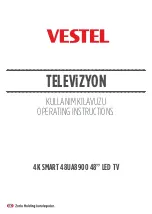
- 6 -
hearing damage.
24. Do not allow the product to output
distorted sound for extended periods
of time. This may cause speaker
overheating and fire.
25. This reminder is provided to call the
cable TV system installer’s attention
to Article 820-40 of the NEC that
provides guidelines for proper
grounding and, in particular, specifies
the cable ground shall be connected
to the grounding system of the
building, as close to the point of cable
entry as practical.
26. The socket-outlet must be installed
near the unit and easily accessible.
27. The main plug is used as the
disconnect and shall remain readily
operable.
CONDENSATION
Moisture will form in the operating
section of the unit if the unit is brought
from cool surroundings into a warm
room or if the temperature of the room
rises suddenly. When this happens the
unit’s performance will be impaired. To
prevent this, let the unit stand in its new
surroundings for about an hour before
switching on, or make sure the room
temperature rises gradually.
Condensation may also form during
the summer if the unit is exposed to the
breeze from an air conditioner. In such
cases, change the location of the unit.
HOW TO HANDLE THE LCD PANEL
●
Do not press hard or jolt the LCD
panel. It may cause the LCD panel
glass to break and injury may occur.
●
If the LCD panel is broken, make
absolutely sure you do not touch the
liquid in the panel. This may cause
skin inflammation.
●
If the liquid gets in your mouth,
immediately gargle and consult with
your doctor. Also, if the liquid gets
in your eyes or touches your skin,
consult your doctor after rinsing for
at least 15 minutes in clean water.
Possible Adverse Effects on LCD
Panel:
If a fixed (non-moving) pattern
remains on the LCD panel for long
periods of time, the image can become
permanently engrained and cause subtle
but permanent ghost images. This type
of damage is NOT COVERED BY YOUR
WARRANTY. Never leave your LCD
panel on for long periods of time while
it is displaying the following formats or
images:
●
Fixed images, such as stock tickers,
video game patterns, TV station
logos and websites.
●
Special formats that do not use the
entire screen. For example, viewing
letterbox style (16:9) media on a
normal (4:3) display (black bars at
top and bottom of screen); or viewing
normal style (4:3) media on a wide
screen (16:9) display (black bars on
left and right sides of screen).
The following symptoms are not signs
of malfunction but technical limitation.
Therefore we disclaim any responsibility
for these symptoms.
●
LCD panels are manufactured
using an extremely high level of
precision technology, however
sometimes parts of the screen may
be missing picture elements or have
luminous spots. This is not a sign of a
malfunction.
●
Do not install the LCD panel near
electronic equipment that produces
electromagnetic waves. Some
equipment placed too near this unit
may cause interference.
●
Effect on infrared devices – there







































